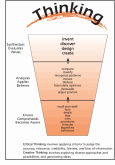

Principles
Higher-Level Critical and Creative Thinking
"Critical thinking is the intellectually disciplined process of actively and skilfully conceptualizing, applying, analyzing, synthesizing, and/or evaluating information gathered from, or generated by, observation, experience, reflection, reasoning, or communication, as a guide to belief and action. In its exemplary form, it is based on universal intellectual values that transcend subject matter divisions: clarity, accuracy, precision, consistency, relevance, sound evidence, good reasons, depth, breadth, and fairness." Defining Critical Thinking (Scriven and Paul)
In the process of constructing understanding, students acquire and store facts, data, details, procedures, formulas, algorithms, and definitions in long-term memory. Then, they compare, classify, recognize patterns, induce/inquire, deduce, formulate opinions, persuade, or argue pro/con to extend their understanding. Deeper learning occurs when students apply higher-level critical and creative thinking to invent, discover, design, and create (see Stages of Thinking Diagram).
 Critical thinking is convergent. It involves using criteria and evidence to assess the worth or validity of information and to make reasoned judgements. These judgements include distinguishing fact from opinion and interpretation, evaluating information and ideas, identifying perspective and bias, and considering the consequences of decisions and actions. In the Developmental Continuum for Literacy with ICT, the Big Ideas "Question and Plan" and "Gather and Make Sense” require critical thinking.
Critical thinking is convergent. It involves using criteria and evidence to assess the worth or validity of information and to make reasoned judgements. These judgements include distinguishing fact from opinion and interpretation, evaluating information and ideas, identifying perspective and bias, and considering the consequences of decisions and actions. In the Developmental Continuum for Literacy with ICT, the Big Ideas "Question and Plan" and "Gather and Make Sense” require critical thinking.

Creative thinking is divergent. Creative thinking generates ideas and possibilities and explores diverse approaches, often by questioning accepted principles. (Manitoba Education and Early Childhood Learning, Kindergarten to Grade 8 Social Studies… TN-37). In the Developmental Continuum for Literacy with ICT, the Big Ideas "Produce to Show Understanding" and "Communicate" tend to require creative thinking. The goal of Literacy with ICT Across the Curriculum is for students to demonstrate increased levels of both critical and creative thinking, supported by ICT.
Both critical and creative thinking increase in complexity as students move across the levels of thinking in Bloom's taxonomy. When constructing understanding at the knowledge and comprehension levels, students acquire information or discrete details and facts, then recall the information, or restate it in their own words. They may retrieve procedures, data, and formulas in order to apply the information at higher thinking levels. (Manitoba Education and Early Childhood Learning, Rethinking Classroom Assessment… 6)
As students mature in their ability to think, and as teachers gradually release responsibility to them, they are able to demonstrate behaviours in the analysis and application levels of Bloom's taxonomy. When students apply their knowledge of methods or theories in new situations, they demonstrate their ability to use the information they have acquired. They may analyze a situation to determine the parts of the whole, or look for patterns to understand the relationship between the parts. When students apply their knowledge within a real life situation, this demonstration of learning is considered authentic. When applying and analyzing information, students begin to formulate opinions, make deductions, and prepare pro/con arguments.
At the synthesis and evaluation levels of thinking, students generate new ideas and form new patterns or ways of thinking as they extend their learning. This is the process of discovery and invention associated with divergent or creative thinking. Students also use criteria to critique new products or processes as they converge toward finding solutions and demonstrating their ability to think critically. Among other things, students distinguish fact from opinion, identify forms of bias, and consider the implications of decisionsResources for Critical and Creative Thinking
For access to more resources about critical and creative thinking, visit the LwICT - Resources for Critical and Creative Thinking site. This site is moderated, if you have a recommended resource that you would like to share, just double click and post your resource to the site.
